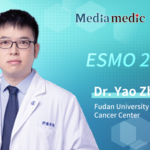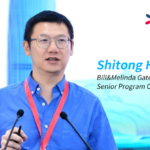
Liver cancer is one of the most common malignant tumors in China, ranking second in cancer-related deaths. This highlights the significant burden of liver cancer prevention and treatment in the country. Currently, under the guidance of integrated medicine, HCC conversion therapy is undergoing unprecedented changes. From September 20-22, 2024, the inaugural "CACA Integrated Liver Cancer Conference," organized by the China Anti-Cancer Association (CACA) and the Integrated Liver Cancer Committee, was held in Changsha and Shenyang. At the conference, Dr. Feng Wang from the Chinese PLA Eastern Theater General Hospital delivered a keynote speech titled "Current Status and Challenges of HCC Conversion Therapy in the Era of Integrated Medicine." In this in-depth interview with Hepatology Digest, Dr. Wang discusses the core significance of conversion therapy in HCC and how breakthroughs in phase III clinical trials of the "TACE + Targeted + Immunotherapy" model are reshaping the treatment landscape for liver cancer.Hepatology Digest: What is the core significance of conversion therapy for HCC under the concept of integrated medicine? How has it changed the traditional treatment approach for liver cancer?
Dr. Feng Wang: “Integrated Medicine” is a concept introduced by Academician Daiming Fan, which aims to combine advanced theoretical knowledge from various medical fields and effective practical experiences from different specialties, while adjusting for social, environmental, and psychological factors. This creates a new medical system better suited for human health and disease treatment. The core significance of HCC conversion therapy lies in offering surgical opportunities to patients with intermediate-to-advanced HCC who were previously inoperable through active intervention, thereby improving their disease-free survival and extending overall survival.
Traditionally, liver cancer treatment is based on staging, with early-stage liver cancer recommended for surgery, intermediate-stage for interventional therapy, and late-stage for drug therapy. However, in clinical practice, most patients in China are diagnosed at intermediate-to-advanced stages, losing the chance for surgical treatment and facing a limited survival period. Encouragingly, due to decades of effort by Chinese researchers, various treatment methods for liver cancer—including liver resection, liver transplantation, ablation, interventional therapy, radiotherapy, chemotherapy, targeted therapy, and immunotherapy—have made significant progress, creating favorable conditions for HCC conversion therapy.
Currently, by reasonably integrating various treatment methods for intermediate-to-advanced HCC patients, the effectiveness of treatment can be significantly improved, tumors can shrink, and downstaging can be achieved, allowing some initially inoperable HCC cases to become operable. This transformation into a “tumor-free state” ultimately increases the overall survival of patients.
In addition, some patients, even after conversion therapy, may not be suitable for surgery, either due to age, comorbidities, or fear of surgery. For such patients, minimally invasive treatments such as curative ablation and stereotactic radiotherapy can achieve tumor inactivation, also leading to a “tumor-free state.” Thus, the population that can benefit from conversion therapy expands, fulfilling the goal of extending survival and improving quality of life. This is the current significance of HCC conversion therapy.
Hepatology Digest: With advancements in medical technology, such as immunotherapy and targeted therapy, how do these emerging therapies impact the efficacy and future prospects of HCC conversion therapy? How do you view their potential in conversion therapy?
Dr. Feng Wang: As we all know, the first approved targeted drug for liver cancer was sorafenib, but its overall response rate was quite low. Although newer targeted drugs like lenvatinib and donafenib have since been developed, the efficacy of single-agent targeted therapies remains under 10% without patient selection. In 2017, immunotherapy entered the field of liver cancer treatment, but monotherapy with immunotherapy showed an efficacy of only about 15%. Since 2020, we have entered the era of combining immunotherapy with targeted therapy, raising the response rate to 20-30%.
However, this efficacy is still unsatisfactory. The main reason is that, unlike other solid tumors like lung, breast, gastric, and colorectal cancers, where driver genes have been identified, the driver genes for liver cancer remain elusive. As a result, targeted drugs approved for liver cancer show limited efficacy. Furthermore, no reliable biomarkers for predicting the efficacy of immunotherapy in liver cancer have been found yet. While immunotherapy is a broad-spectrum anti-tumor drug, its overall response rate across different cancers is only around 15-20%.
Under current circumstances, we need to combine immunotherapy with targeted therapy to improve the response rate. A noteworthy development in recent years is the “TACE + Targeted + Immunotherapy” model, which has achieved success in several large phase III clinical studies.
For example, at the ASCO-GI conference earlier this year, the EMERALD-1 study collaboration reported the main results of the study in an LBA oral presentation. The combination of durvalumab + bevacizumab + TACE showed a significant improvement in median progression-free survival (mPFS) compared to TACE alone (15.0 months vs. 8.2 months), reducing the risk of disease progression or death by 23% (HR=0.77, 95%CI: 0.61-0.98, P=0.032), and markedly increased the response rate (according to mRECIST criteria, 59.7% vs. 48.2%).
Similarly, at the recently concluded ESMO conference, the LEAP-012 study results showed that lenvatinib + pembrolizumab + TACE significantly improved PFS compared to TACE alone, with a median PFS of 14.6 months (95% CI: 12.6-16.7) vs. 10.0 months (95% CI: 8.1-12.2), significantly reducing the risk of disease progression or death (HR=0.66, 95% CI: 0.51-0.84, P=0.0002), and significantly increasing the response rate (according to mRECIST criteria, 71.3% vs. 49.8%).
Additionally, several smaller phase II studies and real-world studies have confirmed that the combination of TACE with immunotherapy and targeted therapies yields similar or even better outcomes.
Thus, in HCC conversion therapy, we hope that the “TACE + Targeted + Immunotherapy” model can achieve response rates of 50-80%, further improving the success rate of conversion therapy.
To further enhance the efficacy of targeted and immunotherapy, we must continue to strengthen basic research, including identifying new therapeutic targets and driver genes for HCC. In immunotherapy, we need to conduct in-depth studies of the tumor immune microenvironment to explore predictive markers of treatment efficacy, allowing us to identify populations most likely to benefit from treatment. This will not only improve treatment outcomes but also avoid waste of medical resources and reduce the financial burden on patients.


